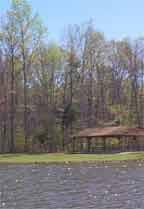City of Burlington: Education to Prevent Contamination

Acting Entity: City of Burlington
Contact Person: Steve Shoaf
Cost: $30,000
Population Served: 50,834
Water Supply: Reservoir Lake Mackintosh, Lake Cammack City of Burlington
PWS ID:0201010
Helping Organizations:
· WRRI (Water Resources Research Institute)
· Alamance and Guilford County Agricultural Extension
· NC State University (NCSU)
Funding Sources:
· City of Burlington
Features:
· Source water protection resulted in significant cost savings.
· Public Education proved to be a valuable tool for change.
Summary: When the pesticide Atrazine was detected in their finished drinking water, the City of Burlington took proactive measures to discover the source of the problem and to protect their drinking water source. In the past, Burlington had cooperated with local farmers to build and maintain sediment retention ponds, but the city recognized the need for action when this new threat was identified.
First city officials needed to determine where this pesticide was coming from. The WRRI and NCSU worked with Burlington to develop a water quality sampling program, subdividing the watershed and sampling the sites frequently. Over several years, the presence of Atrazine was traced to agricultural activities in portions of the water supply watershed. Officials then visually surveyed the area to see what types of crops were being grown and what agricultural practices were associated with the crops.
Burlington had two options to mitigate their Atrazine problem: the city could treat the water or protect the source. Officials in Burlington chose source water protection over treatment and saved a great deal of money in the process.
The next step was to have a dialogue with the farmers in the area. Agricultural Extension agents stepped in to help with this phase. These discussions revealed that most farmers had assumed that their pesticides were removed at the water treatment plant. Furthermore, farmers were surprised pesticide use resulted in the presence of pesticides in the drinking water supply. Through informal education the farmers learned that conventional water treatment couldn't remove some organic pollutants. Having learned these facts, many farmers voluntarily transitioned to using less persistent pesticides and adopted other practices such as observing buffer area next to streams to reduce the use and water transport of Atrazine.
The source water protection approach resulted in a life of project total cost of $30,000 to Burlington, which was used for lab analyses and subsidies to farmers. The estimated cost for treatment using activated carbon was over $100,000 per year. Collaborating with the WRRI and NC State University allowed Burlington to pay reduced lab fees for lab analyses.
These actions brought about the first significant drops in the levels of Atrazine. To support the farmer's efforts, the city decided to subsidize farmer's expenses as they transitioned to new practices and maintained no-planting zones along streams. Significant change has occurred: Atrazine has been eliminated in two of the three locations originally identified as problems. Atrazine is still intermittently detected in source water samples from the third area. The source of the problem continues to be elusive; however, but officials are not giving up.
